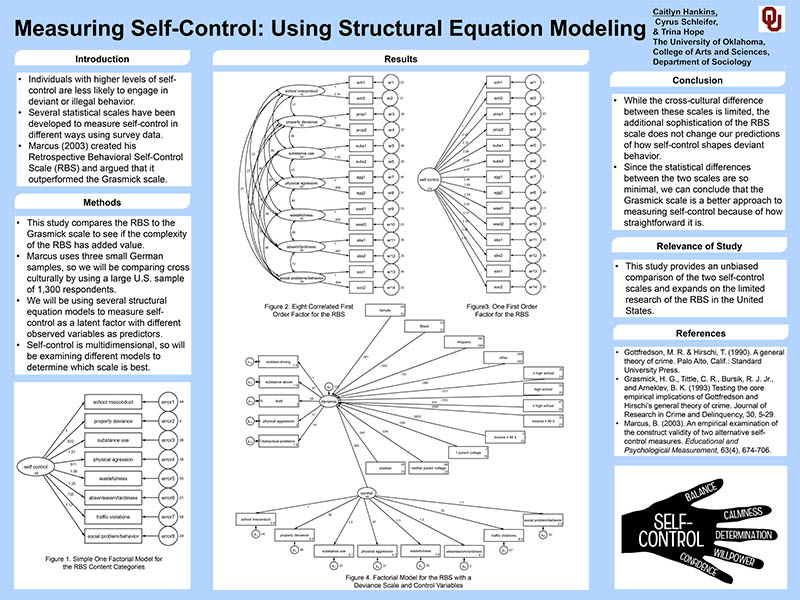
Hover to pan and click to magnify. Click again to pan at full screen.
Caitlyn A. Hankins, C. Schleifer and T. Hope, Dept. of Sociology, University of Oklahoma, Norman, OK. Faculty Advisor, Dr. Cyrus Schleifer, University of Oklahoma, Norman, OK.
Caitlyn A. Hankins, C. Schleifer and T. Hope, Dept. of Sociology, University of Oklahoma, Norman, OK. Faculty Advisor, Dr. Cyrus Schleifer, University of Oklahoma, Norman, OK.
ABSTRACT
Introduction: Research has shown that individuals with higher levels of self-control are less likely to engage in deviant or illegal behavior. In order to explore this relationship empirically, several different statistical scales have been developed in an attempt to measure self-control in different ways using survey data. In 2003, Marcus (2003) created his Retrospective Behavioral Self-Control Scale (RBS) and argued that it outperformed the Grasmick scale in several important ways. The sample for his analyses came from Germany, and we have reason to expect the cultural difference between Germany and the United States might lead to these scales performing differently across these different cultural environments.
Methods: Using a nationally representative sample of 1,300 respondents collected through YouGov, this study replicates Marcus’ (2003) examination of his Retrospective Behavioral Self-Control Scale (RBS) compared to the Grasmick Scale. We compare the two scales with several advanced statistical models and structural equation approaches to scaling. In addition to mapping out the cross-cultural differences in self-control, we explore whether and to what degree the complexity of the RBS scale outperforms (or fails to outperform) the easier to collect and implement Grasmick scale.
Results: We find that while the cross-cultural difference between these scales are limited, the additional sophistication of the RBS scale does not necessarily change our predictions of how self-control shapes deviant behavior. When simply comparing the two basic models for the RBS and the Grasmick scale, there is no significant difference. After incorporating the control variables and the deviance scale into the models, the RBS still outperforms the Grasmick scale but only marginally.
Conclusion: The RBS is shown to have slightly better fit statistics across all of the models we examined; however, the Grasmick scale is much more robust. Therefore, since the statistical differences are so minimal, we can conclude that the Grasmick scale is a better approach to measuring self-control because of how straightforward it is.
Relevance of Study: This study provides an unbiased comparison of the two self-control scales and expands on the limited research of the RBS in the United States.

DISQUS COMMENTS WILL BE SHOWN ONLY WHEN YOUR SITE IS ONLINE